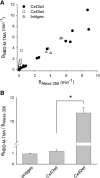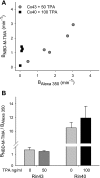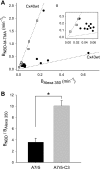Regulation of gap junctional charge selectivity in cells coexpressing connexin 40 and connexin 43
- PMID: 19465552
- PMCID: PMC2711728
- DOI: 10.1152/ajpheart.00287.2009
Regulation of gap junctional charge selectivity in cells coexpressing connexin 40 and connexin 43
Abstract
Expression of connexin 40 (Cx40) and Cx43 in cardiovascular tissues varies as a function of age, injury, and development with unknown consequences on the selectivity of junctional communication and its acute regulation. We investigated the PKC-dependent regulation of charge selectivity in junctions composed of Cx43, Cx40, or both by simultaneous assessment of junctional permeance rate constants (B(dye)) for dyes of similar size but opposite charge, N,N,N-trimethyl-2-[methyl-(7-nitro-2,1,3-benzoxadiol-4-yl)amino]ethanaminium (NBD-M-TMA; +1) and Alexa 350 (-1). The ratio of dye rate constants (B(NBD-M-TMA)/B(Alexa 350)) indicated that Cx40 junctions are cation selective (10.7 +/- 0.5), whereas Cx43 junction are nonselective (1.22 +/- 0.14). In coexpressing cells, a broad range of junctional selectivities was observed with mean cation selectivity increasing as the Cx40 to Cx43 expression ratio increased. PKC activation reduced or eliminated dye permeability of Cx43 junctions without altering their charge selectivity, had no effect on either permeability or charge selectivity of Cx40 junctions, and significantly increased the cation selectivity of junctions formed by coexpressing cells (approaching charge selectivity of Cx40 junctions). Junctions composed of Cx43 truncated at residue 257 (Cx43tr) were also not charge selective, but when Cx43tr was coexpressed with Cx40, a broad range of junctional selectivities that was unaffected by PKC activation was observed. Thus, whereas the charge selectivities of homomeric/homotypic Cx43 and Cx40 junctions appear invariant, the selectivities of junctions formed by cells coexpressing Cx40 and Cx43 vary considerably, reflecting both their relative expression levels and phosphorylation-dependent regulation. Such regulation could represent a mechanism by which coexpressing cells such as vascular endothelium and atrial cells regulate acutely the selective intercellular communication mediated by their gap junctions.
Figures







 ) and A7r5 (•) cell junctions (dotted lines are the linear regression fits for Cx40 and Cx43 junctions as shown in Fig. 2A). Inset shows data near graph origin at expanded scaling of both axes. B: the average charge selectivities (BNBD-M-TMA/BAlexa 350) of A7r5 and A7r5-C3 junctions are significantly different, P < <0.001. *Selectivity of A7r5-C3 junctions significantly greater than A7r5 junctions (Student's t-test).
) and A7r5 (•) cell junctions (dotted lines are the linear regression fits for Cx40 and Cx43 junctions as shown in Fig. 2A). Inset shows data near graph origin at expanded scaling of both axes. B: the average charge selectivities (BNBD-M-TMA/BAlexa 350) of A7r5 and A7r5-C3 junctions are significantly different, P < <0.001. *Selectivity of A7r5-C3 junctions significantly greater than A7r5 junctions (Student's t-test).

Similar articles
-
Cx40 and Cx43 expression ratio influences heteromeric/ heterotypic gap junction channel properties.Am J Physiol Cell Physiol. 2002 Jun;282(6):C1469-82. doi: 10.1152/ajpcell.00484.2001. Am J Physiol Cell Physiol. 2002. PMID: 11997262
-
Gap junction permeability: selectivity for anionic and cationic probes.Am J Physiol Cell Physiol. 2011 Mar;300(3):C600-9. doi: 10.1152/ajpcell.00316.2010. Epub 2010 Dec 9. Am J Physiol Cell Physiol. 2011. PMID: 21148413 Free PMC article.
-
Gap junction channels formed by coexpressed connexin40 and connexin43.Am J Physiol Heart Circ Physiol. 2001 Oct;281(4):H1675-89. doi: 10.1152/ajpheart.2001.281.4.H1675. Am J Physiol Heart Circ Physiol. 2001. PMID: 11557558
-
Emerging issues of connexin channels: biophysics fills the gap.Q Rev Biophys. 2001 Aug;34(3):325-472. doi: 10.1017/s0033583501003705. Q Rev Biophys. 2001. PMID: 11838236 Review.
-
Pharmacological modulation and differential regulation of the cardiac gap junction proteins connexin 43 and connexin 40.Biol Cell. 2002 Nov;94(7-8):409-22. doi: 10.1016/s0248-4900(02)00018-7. Biol Cell. 2002. PMID: 12566216 Review.
Cited by
-
Interfering amino terminal peptides and functional implications for heteromeric gap junction formation.Front Pharmacol. 2013 May 21;4:67. doi: 10.3389/fphar.2013.00067. eCollection 2013. Front Pharmacol. 2013. PMID: 23734129 Free PMC article.
-
Patch clamp studies on TRPV4-dependent hemichannel activation in lens epithelium.Front Pharmacol. 2023 Feb 24;14:1101498. doi: 10.3389/fphar.2023.1101498. eCollection 2023. Front Pharmacol. 2023. PMID: 36909173 Free PMC article.
-
Inducible coexpression of connexin37 or connexin40 with connexin43 selectively affects intercellular molecular transfer.J Membr Biol. 2012 Jun;245(5-6):231-41. doi: 10.1007/s00232-012-9444-4. Epub 2012 Jun 23. J Membr Biol. 2012. PMID: 22729648 Free PMC article.
-
Nitric oxide, PKC-ε, and connexin43 are crucial for ischemic preconditioning-induced chemical gap junction uncoupling.Oncotarget. 2016 Oct 25;7(43):69243-69255. doi: 10.18632/oncotarget.12087. Oncotarget. 2016. PMID: 27655723 Free PMC article.
-
Calcium Role in Gap Junction Channel Gating: Direct Electrostatic or Calmodulin-Mediated?Int J Mol Sci. 2024 Sep 10;25(18):9789. doi: 10.3390/ijms25189789. Int J Mol Sci. 2024. PMID: 39337278 Free PMC article. Review.
References
-
- Aavula BR, Ahad Ali M, Mash EA, Bednarczyk D, Wright SH. Synthesis and fluorescence of N,N,N-trimethyl-2-[methyl(7-nitrobenzo[c][l,2,5]oxadiazol-4-yl) amino]ethanaminium iodide, a pH-insensitive reporter of organic cation transport. Synth Commun 36: 701–705, 2006.
-
- Bolon ML, Kidder GM, Simon AM, Tyml K. Lipopolysaccharide reduces electrical coupling in microvascular endothelial cells by targeting connexin40 in a tyrosine-, ERK1/2-, PKA-, and PKC-dependent manner. J Cell Physiol 211: 159–166, 2007. - PubMed
-
- Bolon ML, Peng T, Kidder GM, Tyml K. Lipopolysaccharide plus hypoxia and reoxygenation synergistically reduce electrical coupling between microvascular endothelial cells by dephosphorylating connexin40. J Cell Physiol 217: 350–359, 2008. - PubMed
Publication types
MeSH terms
Substances
Grants and funding
LinkOut - more resources
Full Text Sources
Miscellaneous

